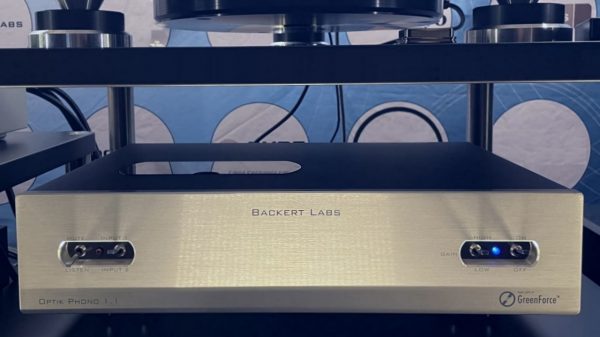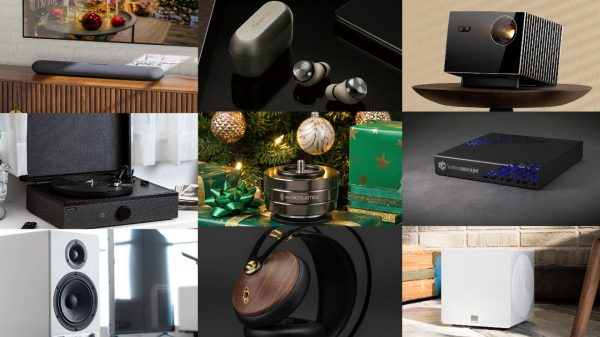Big Power: Axiom’s A1400-8 Digital Amp Dumps a Kilowatt (or more) into any Channel That Needs It
Some things in life are just better when they’re smaller – cell phones, laptop computers, and stomachs! But other things are much better when they’re bigger, such as your paycheck, your back yard, and power amplifiers. Actually, an ideal power amp combines some of both–you want tons of high-power output and reserve, but in a compact enclosure.
As flat-screen TV and video projection technology prices decline, we’re all after the home theater big-screen experience. Viewing high-definition images on a large-screen video display simply makes the entertainment experience that much more real and closer to life. But the visual component is just half the experience. As Hollywood film directors and composers have known for years, high-quality 5.1- or 7.1-channel music and movie soundtrack playback greatly enhance the drama and emotional involvement of the listener and viewer.
Increasing numbers of two-channel stereo enthusiasts, who for years believed that music of all sorts could be adequately reproduced by two channels, are coming to appreciate what 4-to-7-channel playback can add to musical involvement: those extra four or more channels of sound push out the walls of your living room or home theater almost immeasurably, substituting the ambient spaces of the original recording venue for the tight confines of a domestic room. Great hi-fidelity reproduction is not just about smooth and linear frequency response but about space and spatial perception. Music playback deprived of its spatial and ambient cues is diminished.
So what’s left?
Dynamics! –the audible range from very soft sounds to tremendously loud sounds. Our ears have no problem accepting this wide dynamic range. From the earliest times our ancestors were able to detect the rustling of a breeze through the leaves, or the rumbles of thunder and cracks of lightning that signaled an approaching storm. As musical instruments were invented and refined, they eventually encompassed similar ranges of dynamic expression, and composers exploited the dynamic range of their music to create emotional and thrilling effects, from the barely audible “ting” of a triangle to the rumbling of bass drums and pounding of timpani.
The introduction in the 1950s of amplification and electric pickups to pop and rock music dramatically increased the dynamic range of the once-modest acoustic guitar, and added a pounding and propulsive drive to rock ‘n’ roll that carries through to this day.
At one time or another we’ve all experienced musical extremes in live concerts, in clubs, and in big cinemas. But reproducing those dynamics in a home theater or living room has inevitable limits imposed mainly by two components in the chain–the amplifier and the speakers.
Axiom has done a lot to overcome the limitations of its loudspeakers in their ability to handle large inputs of power and encompass a big dynamic range without distortion or compression.
But until recently, the amplifier end of the spectrum was out of our control. Many receiver manufacturers rate power output based on one or two channels driven (not seven), often specified at a single frequency, to suggest that their products are capable of high power output in all available channels, when indeed clipping of the output devices or clamping of power output imposes real limitations on the dynamic range. Turn up the AV receiver, and the sound may became harsh or edgy—a sure sign of rising harmonic and intermodulation distortion, intermittent clipping, or intrinsic power supply limitations imposed by current-limiting circuitry. Low-powered tube amplifiers rely on a “musically accommodating” or “harmonically agreeable” mode of clipping to gloss over the fact that they are in fact distorting the output signal. Drive a tube amp into clipping and the sound gets mushy and the soundstage contracts.
An instructive display of these effects was conducted at a recent high-end audio and home entertainment show in New York. The demonstration used a blind comparison of a 35-watt-per-channel tube amplifier driven into clipping against a 200-watt-per-channel solid-state amp. The attendees at the show were largely hi-end aficionados and were able to instantly switch back and forth between the tube amplifier and the solid-state amplifier not knowing which one they were listening to. Only after the test was completed were they told which colored light represented which amplifier. Virtually all the listeners–the hotel room held about a dozen, including this writer –preferred the solid-state amplifier to the tube amp, because during peak dynamics, when the tube amp went into clipping and the sound got mushy, the stereo soundstage disappeared (an effect I’d never heard before). By contrast, the solid-state amplifier remained musical, with the soundstage open, spacious and free of constricted dynamics. Full marks go to Stereophile magazine and John Atkinson, its editor, who helped sponsor the demo.
Of course no one denies that the solid-state amp might have produced nasty and edgy sound quality had it been driven into hard clipping. In fact, the engineer who addressed the group demonstrated a circuit of his own design that induced the solid-state amp to “soft-clip”, or in his words, put “dirty skirts” around the edges of the waveform rather than severely truncating it, which is what normally occurs with hard clipping of solid-state amplifiers.
The best lesson from the excellent demonstration was that clipping of any kind of amplifier–tube or solid-state–is something to avoid if you want to keep reproduced sound clean, open, unrestricted and spacious.
With the development and introduction of Axiom’s new A1400-8 digital power amplifier, the last hurdle of restricted dynamics and clipping has been overcome. The A1400-8 uses new and innovative circuitry that monitors and dynamically distributes its 1,400 watts of power among as many channels as are connected (up to eight). If the three front channels demand a burst of hundreds of watts per channel to handle a brief dynamic peak in the music or soundtrack, those three channels will get it, with no distortion or “clipping” or electronic shackles on the output. The Axiom A1400-8 assigns power when and where required, regardless of how many channels are connected.
Receiving rushes of current and voltage unfettered lets the voice coils of each speaker driver move in accordance with the music signal at whatever dynamic levels are dictated by the original recording, the listener’s room, and the speakers being driven. For large floorstanding multi-driver speakers like the Axiom M80 v2s and M60 v2s, the Axiom A1400-8 digital power amplifier removes previous barriers to unrestricted dynamic music reproduction.
As Ian Colquhoun, president and chief designer of Axiom Audio, recently stated, “The A1400-8 digital amplifier is not only innovative, but also a real money-saver for quality home audio and home theater systems. Duplicating this kind of dynamic headroom with other amplifiers would require a stack of expensive monoblock amps. The A1400-8’s output power can satisfy the needs of exceptionally large media or living rooms, yet still deliver live sound quality even at high volume.”
The A1400-8 digital amplifier is now available for purchase direct from Axiom for $3,850, including shipping. To learn more or to place an order, log on to www.axiomaudio.com/A1400-8.html. The first run of amplifiers has sold out and the next run begins shipping October 16th.
































